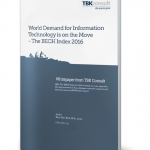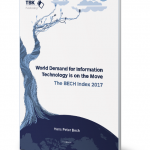Description
Podcast
Transcript
Happy New Year!
This first day of the year may be a good time to consider the one thing that you should do differently in the future — one thing that will make a massive difference for yourself and those around you. May I suggest that one thing is the systematic application of the Alexander Osterwalder business model framework?
Using the Alexander Osterwalder business model framework will give you the following advantages:
- You can quickly kill ideas that at first glance sound great but cannot survive the test of the business model analysis (it is unlikely that ideas that don’t work on paper will work in real life).
- The ideas that pass the business model analysis are better documented and better understood by the people who are to implement them.
- By having a common framework and language, you will save enormous amounts time. You can cut to the core of new ideas much faster and with less effort.
- You will have a business development language that you can take with you and apply anywhere (the same way that the English language will enable you to communicate with people all over the world).
- You can quickly analyze, ask relevant questions about and finally understand the business models of your customers, your channel partners, your co-workers, your suppliers, your strategic alliances and your investors. With this simple tool, you can maximize the value that your business model offers all the stakeholders on which you depend.
Where does the term business model originate?
The term “business model” became widely used by the end of the 90’s in conjunction with the introduction of the “new economy.” After the dot-com bubble, in 2001, we learned that the “new economy” had to follow the same laws as the old economy. However, especially in the information technology industry, there still was a need for explaining why it could make sense to invest millions in companies that hardly had any revenue and were unprofitable. The business model became the standard phrase used to explain how you could turn a brilliant idea that lost money into a booming business in the future. But, it wasn’t until 2010 when Alexander Osterwalder et al. published the book Business Model Generation that we got a complete framework for what a business model is. Before Alexander Osterwalder, we still wasted tons of time discussing what the business model format was in addition to discussing the business itself. It was like building the Tower of Babylon, where differences in languages stood in the way of solving the actual challenges.
When will the business model framework cross the chasm?
Alexander Osterwalder taught us that the business model framework was not for exotic startups only. All types of business issues in all kinds of organizations would benefit immensely by applying a common structure and a common language.
Alexander Osterwalder et al. published the Business Model Generation book in July 2010, promising vast improvements in the business development discipline. And, while the business model framework can be learned at a little cost, we are still at the start of the adoption curve (it has always puzzled me that people who are supposed to be innovators are slow to adopt and use new business development frameworks). I hope this post and my little present for you at the end can help you climb the adoption curve a bit faster.
The business model framework at a glance
The business model framework has nine building blocks, and the explanation of your brilliant idea for starting or improving a business needs to include them all.
You mostly start by clarifying your value proposition and its attractiveness to particular kinds of customers (often called the product-market fit). Then, you explain the channels required to find, nurture, mature, activate, develop, and win new customers (often called your go-to-market approach) and the customer relationships required to make, keep, and grow happy customers (often called customer success). You complete the story by showing how the revenue flows through your channel and customer relationships. These five building blocks make up your business model front office.
The next step is to explain the business model back office required to drive the front office. You describe the activities required, the resources needed, and the strategic relationships that you must have in place to deliver your value proposition successfully. You end the story by estimating the cost required to run the back office.
When you have done your business model homework, you have a preliminary P&L Statement (Profit & Loss) that can be refined as you mature the project.
Most users of the business model framework stop here, but that’s way too early. While most of the business model building blocks are within your full control (revenue is the exception), you have to operate in a world that is completely outside your control. You need to make it to page 200 in the Business Model Generation book before you are introduced to the business model environment, describing the external powers and trends that impact your venture.
With the first version of your business model and the environment documented, you can start to refine and optimize. The last sixteen pages of the book spell out the format for running a business model design process within your company.
My New Year present for you
If you haven’t bought the Business Model Generation book yet, then I suggest you do so now. After reading the book and using the framework for the first time you will be left with a big question: How do I implement my business model?
I have written an e-book giving you the format for generating revenue. The e-book will be published by the end of January, but as my faithful reader, you can get it now.
Click to download: Revenue Generation — Facilitating the Buyer’s Journey.
Happy New Year and may your 2017 projects turn out successfully for your customers, your co-workers, your suppliers, your channel partners, your strategies alliances, your investors and you.








